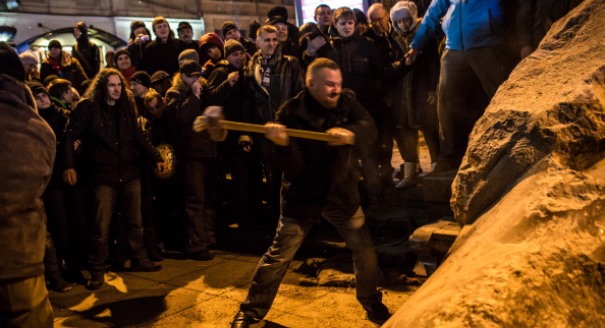The demonstrations in Ukraine’s capital on December 7–8 were huge. Hundreds of thousands of people gathered in Kiev’s Independence Square for the third consecutive weekend of major protests.
This is not the first time Kiev has seen such a wave of demonstrations. Nine years ago, the Orange Revolution raised a hope of genuine change. But as the country’s leadership descended into infighting and corruption, prodemocracy Ukrainians and their European and American sympathizers were left short. The real revolution never happened, also because of Ukraine’s close ties to Russia and the ambiguous role of its wealthy oligarchs.
Ukraine now has another chance because of a series of recent changes there and in the EU.
First, over the past few days, Ukrainian protesters have shifted their focus. Originally, it was Ukrainian President Viktor Yanukovych’s refusal to sign a new association agreement with the EU that set off the protests in Kiev.
The promise of closer trade, political, and social ties with the EU had a psychological and symbolic importance for many Ukrainians, even though the accord made no mention of Ukraine ever joining the EU. The fact that Yanukovych gave in to Russia, which had exerted intense pressure primarily through trade embargoes, was a big blow to many Ukrainians, particularly the younger generation.
Now, however, the demonstrators are protesting against the endemic corruption that has bedeviled Ukraine ever since it declared its independence from the former Soviet Union in 1991. This is important.
Yes, moving closer to Europe continues to matter—just look at the EU flags fluttering alongside Ukrainian flags on Independence Square. But Ukrainians are now focusing on the malfunctioning of their own society: the neglected infrastructure and the bribery, the absence of transparency in the government, and the huge political influence of the oligarchs.
A second factor that has changed is Germany. Chancellor Angela Merkel has been very supportive of the protests. In Kiev last week, Guido Westerwelle, Germany’s outgoing foreign minister, stood alongside Vitali Klitschko, the heavyweight boxer who has become the leader of Ukraine’s opposition. The crowds applauded.
Westerwelle’s presence was a signal to Vladimir Putin, the Russian president, that this time around, Germany was not going to remain silent and allow Russia to dictate Ukraine’s political and economic direction.
What a contrast to the Orange Revolution, when former chancellor Gerhard Schröder, a close friend of Putin’s, distanced himself from what was happening in Ukraine.
Merkel, who, in contrast to Schröder, has repeatedly criticized Putin for human rights violations, has taken an unusually strong stance on Ukraine. During a speech in the German Bundestag just days before last month’s Eastern Partnership summit in Vilnius, she said that Ukraine must choose its own political orientation. Russia, she insisted, had no veto.
To confirm Berlin’s shift, the Chancellery intends to invite Klitschko to the European People’s Party, a gathering of European conservative political parties, which will meet in Brussels later this month. In another snub to Putin, Germany’s President Joachim Gauck announced that he would not be attending the opening ceremony of the 2014 Winter Olympics in Sochi.
The third change has to do with a statue of Lenin. During the early 1990s, giant Soviet-era statues of Lenin were pulled down in most Eastern and Central European capitals. That destruction symbolized the break with Moscow. On Sunday, Kiev finally had its turn. A group of protesters toppled the statue that had for decades stood at the top of Shevchenko Boulevard, not far from Independence Square.
The fourth change is that Catherine Ashton, the EU’s top diplomat, will travel to Kiev to try to mediate between the government and protesters. Ashton has substantial credibility after leading international negotiations with Iran on its nuclear program and her success in brokering a deal between Serbia and Kosovo.
But time is short. The EU cannot risk Ukraine slipping into violence or anarchy. The price would be extremely high—not least because of how Russia might react.
With all of these factors of change, Ukraine is going through immense upheaval. Putin is desperate to hold on to the country, knowing full well that if Ukraine goes over to the EU, Russia’s own bulwarks against the EU’s creeping democratic influences will crumble.
Of course, that is exactly what the EU—especially Poland and the Baltic states—wants. Those countries would like Ukraine to be integrated into the EU to act as a buffer against Russia. They also want a democratic Ukraine because it would be a more predictable neighbor.
After three weeks of protests, it is clear that Ukraine’s present, dysfunctional system is neither sustainable nor stable. Ashton and Merkel realize what is at stake. Ukrainians deserve to have their second revolution succeed.








